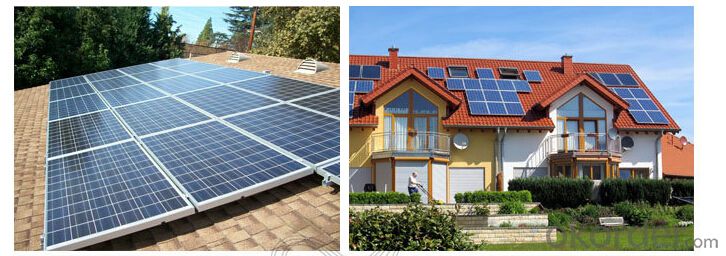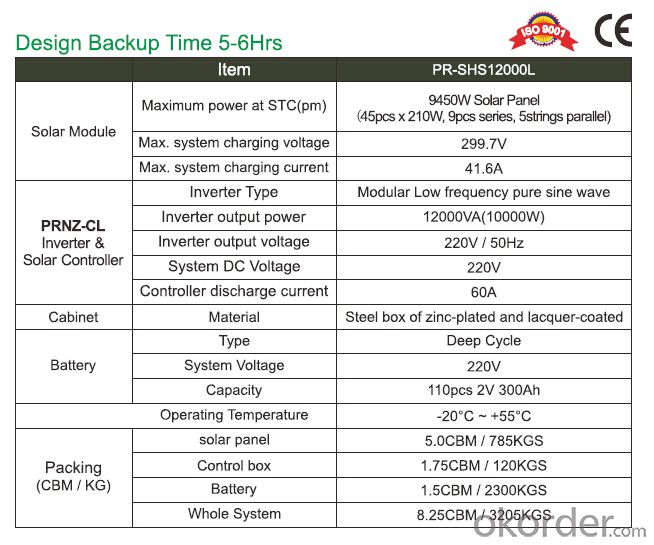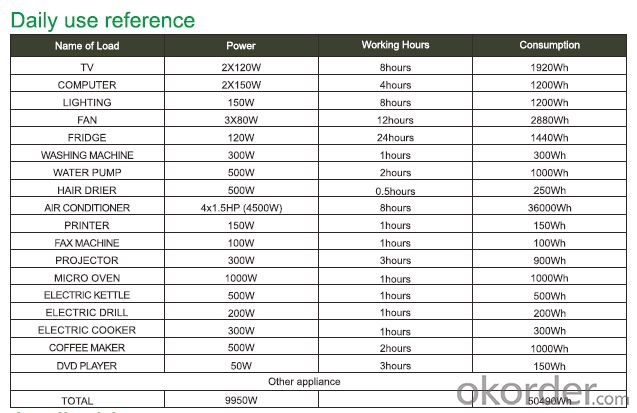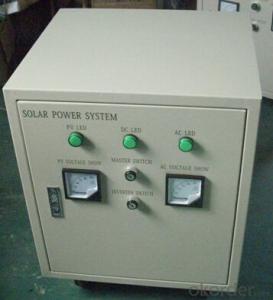CNBM SOLAR Roof Solar System 12000W Popular in Africa
- Loading Port:
- Shanghai
- Payment Terms:
- TT OR LC
- Min Order Qty:
- 1 PCS
- Supply Capability:
- 3000 PCS/month
OKorder Service Pledge
OKorder Financial Service
You Might Also Like
Introduction of Solar Home System
The basic PV or solar cell typically produces only a small amount of power. To produce more power, solar cells (about 40) can be interconnected to form panels or modules. PV modules range in output from 10 to 300 Watts. If more power is needed, several modules can be installed on a building or at ground-level in a rack to form a PV array.
In addition to solar cells, a typical PV module or solar panel consists of these components:
A transparent top surface, usually glass
An encapsulant -- usually thin sheets of ethyl vinyl acetate that hold together the top surface, solar cells, and rear surface
A rear layer -- a thin polymer sheet, typically Tedlar, that prevents the ingress of water and gases
A frame around the outer edge, typically aluminum.
Energy performance ratings for PV modules include the following:
Peak Watt -- Measures the maximum power of a module under laboratory conditions of relatively high light level, favorable air mass, and low cell temperature. These conditions are not typical in the real world.
Normal operating cell temperature -- Measures a module's nominal operating cell temperature after the module first equilibrates with a specified ambient temperature. It results in a lower Watt value than the peak-Watt rating, but it is probably more realistic.
AMPM Standard -- Measures the performance of a solar module under more realistic operating conditions. It considers the whole day rather than "peak" sunshine hours, based on the description of a standard solar global-average day (or a practical global average) in terms of light levels, ambient temperature, and air mass.



Working Principle of Solar Roof System
The stand alone Solar Home System is an off-grid solar system which uses batteries to store the solar energy. Stand alone solar system solutions design for those who are not able or willing to connect to electricity grid.
Specification of Solar Home System


Product Features of Solar Home System
1. Off grid solar power system is mainly used for application with relatively-small power consumption, and the areas have no grid network coverage, or grid power is unstable or outage condition.
2. It’s composed of solar panels, hybrid solar inverter, battery bank, solar panel mounting racks, and other accessories required fora complete home solar power system.
3. The battery bank gives a stable power output to the solar inverter which converts DC to AC to power loads, and provides power backup in rainy or cloudy days.
4. The solar panels generate electricity at daytime and charge the battery bank.
5. The off grid home solar power system provides grid power bypass in case of battery power shortage when sunshine is not enough.
6. All the off grid home solar power system configurations are worked out by scientific calculation and design.
Advantage of Our Solar Home System
1 Excellent Performance: Our Solar Home System is composed by Brand Standard Kits with high quality. Our solar system has the advantage of high efficiency and stable operation. We can ensure our product with a long life period.
2. Small Orders Accepted: We can accept small orders as our customer’s trial order.
3. Warehouse: We have warehouse overseas which can bring great convenience to our customer to pick up the products.
Terms and Conditions
1. Trade terms: FOB Shanghai
2. Payment terms: 30% T/T, balanced before shipment/ LC at sight before shipment. Actual Terms can be negotiated for big order.
3. Package: Exported standard package suitable for tough handling and sea transport.
4. Delivery: Goods to be ready within 10~30 days depending on order quantity.
5. Warranty: 10 years for solar panel, 2 years for controller/inverter/battery.
FAQ
Q: Could you introduce the background of your company?
A: We are a Group corp. with 1GW capacity in China, which is Okorder’s registered VIP Supplier, possess Financial Service from Okorder.com.
Q: Required mainly certificates (CE&IEC/TUV/RoHS)?
A: Our products are certificated by CE RoHS, IEC, ISO, TUV, UL etc.
Q: Your main exported market is?
A: Main markets of our products is: South-east Asia, Mid-east, Arica, East Europe and Latin America.
- Q:What materials are used in solar cells?
- The most common materials used in solar cells are silicon, which is the primary component, along with other materials like metal conductors, glass, and polymers.
- Q:What is the role of tracking systems in maximizing solar cell efficiency?
- Tracking systems play a crucial role in maximizing solar cell efficiency by continuously adjusting the position of solar panels to optimize their exposure to sunlight. This ensures that the panels are always facing the sun at the optimal angle, resulting in increased energy capture and higher overall efficiency.
- Q:Can solar cells be used for powering satellites?
- Yes, solar cells can be used for powering satellites. Solar cells are often used as the primary power source in satellites due to their ability to convert sunlight into electricity. The solar cells are typically mounted on the satellite's surface to capture sunlight and generate power for various systems and instruments onboard.
- Q:What is the role of anti-reflective coatings in solar cells?
- The role of anti-reflective coatings in solar cells is to minimize the reflection of sunlight that hits the surface of the solar cell. By reducing reflection, more light can be absorbed by the solar cell, thus increasing its overall efficiency and power output. This allows for better utilization of sunlight and helps to maximize the energy conversion process in solar cells.
- Q:How big are solar cells?
- Solar cells vary in size depending on their intended use and technology. Traditional silicon-based solar cells typically range in size from a few square centimeters to around 200 square centimeters. However, advancements in solar technology have led to the development of smaller, more efficient solar cells, known as thin-film solar cells, which can be as small as a few square millimeters. Additionally, solar cells can be grouped together to form larger arrays, which are commonly used in residential, commercial, and utility-scale solar installations.
- Q:Can solar cells be recycled?
- Yes, solar cells can be recycled. The process involves separating and recovering valuable materials like silicon, silver, and aluminum from the cells. This not only reduces waste but also allows for the reuse of these materials in the production of new solar cells.
- Q:Can solar cells be used for powering mining operations?
- Yes, solar cells can be used for powering mining operations. Solar energy can be harnessed through photovoltaic cells, which convert sunlight into electricity. By installing solar panels, mining operations can reduce their dependence on fossil fuels and lower their carbon footprint. Solar power can be used to run equipment, lighting, and other electrical systems required for mining operations. Additionally, solar energy can be stored in batteries for use during non-sunlight hours, ensuring a continuous power supply.
- Q:How do solar cells perform in desert environments?
- Solar cells perform exceptionally well in desert environments due to the abundance of sunlight and high temperatures. The vast open spaces and lack of cloud cover allow solar panels to receive maximum exposure to sunlight, resulting in higher energy production. Additionally, the dry and arid conditions in deserts help reduce dust and dirt accumulation on panels, ensuring optimal performance and efficiency.
- Q:Can solar cells be used for large-scale power generation?
- Yes, solar cells can certainly be used for large-scale power generation. They have the potential to harness abundant sunlight and convert it into electricity on a massive scale. As technology and efficiency of solar cells continue to improve, they are increasingly being deployed in utility-scale solar farms, providing a sustainable and renewable source of power to meet the growing energy demands of our society.
- Q:Can solar cells be used in powering remote weather stations?
- Yes, solar cells can be used to power remote weather stations. Solar cells convert sunlight into electricity, making them an ideal and sustainable power source for remote locations where access to traditional power grids may be challenging. The abundance of sunlight in many regions allows solar cells to efficiently generate electricity, providing a reliable source of power for remote weather stations.
1. Manufacturer Overview |
|
|---|---|
| Location | |
| Year Established | |
| Annual Output Value | |
| Main Markets | |
| Company Certifications | |
2. Manufacturer Certificates |
|
|---|---|
| a) Certification Name | |
| Range | |
| Reference | |
| Validity Period | |
3. Manufacturer Capability |
|
|---|---|
| a)Trade Capacity | |
| Nearest Port | |
| Export Percentage | |
| No.of Employees in Trade Department | |
| Language Spoken: | |
| b)Factory Information | |
| Factory Size: | |
| No. of Production Lines | |
| Contract Manufacturing | |
| Product Price Range | |
Send your message to us
CNBM SOLAR Roof Solar System 12000W Popular in Africa
- Loading Port:
- Shanghai
- Payment Terms:
- TT OR LC
- Min Order Qty:
- 1 PCS
- Supply Capability:
- 3000 PCS/month
OKorder Service Pledge
OKorder Financial Service
Similar products
New products
Hot products
Related keywords



























